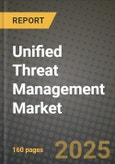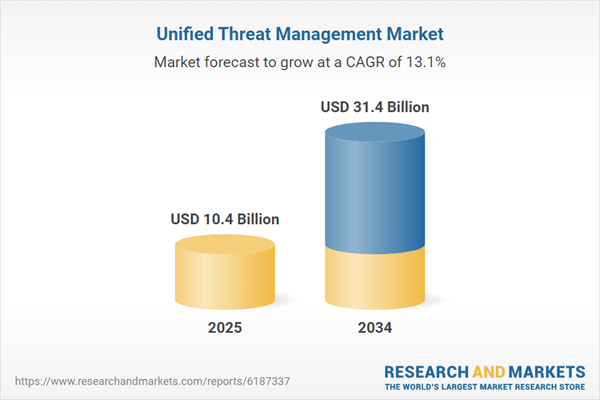The Unified Threat Management (UTM) market has been a crucial component of modern cybersecurity strategies, offering businesses an integrated platform to safeguard their networks from a wide range of cyber threats. UTM solutions combine multiple security functionalities, including firewall protection, intrusion detection, anti-virus, anti-spam, and content filtering, into a single device or platform. This consolidation reduces the complexity of managing multiple security tools, simplifies deployment, and enhances threat detection and response. With the rising frequency and sophistication of cyberattacks, organizations of all sizes are increasingly turning to UTM systems to streamline their security infrastructure while maintaining robust protection against evolving threats. The UTM market has expanded significantly due to the increasing need for comprehensive security solutions, the adoption of cloud technologies, and the growing importance of compliance with data privacy regulations. Additionally, as remote work and Bring Your Own Device (BYOD) policies become more prevalent, UTM systems have adapted to protect a more diverse and dispersed workforce, ensuring that every endpoint within a network remains secure. The growing reliance on UTM platforms can also be attributed to the shift from traditional perimeter security to more advanced, layered security approaches that address the complexities of today’s threat landscape.
The UTM market is expected to continue experiencing strong growth, driven by the increased frequency of cyber threats and the expanding attack surface as businesses embrace digital transformation. As cybercriminals increasingly target enterprises through advanced persistent threats (APTs), UTM solutions will evolve to provide enhanced threat detection, real-time threat intelligence, and automation for quicker response times. Moreover, UTM systems are expected to become more integrated with emerging technologies such as artificial intelligence (AI), machine learning (ML), and cloud-native architectures. These innovations will help UTM systems detect previously unknown threats, offer predictive analytics, and automate processes to mitigate risks more effectively. In response to the growing need for security solutions that scale with organizations, UTM providers will continue to enhance their offerings with cloud-based and hybrid deployment options that provide greater flexibility, cost efficiency, and scalability. Additionally, regulatory pressure regarding data privacy and security will prompt organizations to increasingly adopt UTM solutions that ensure compliance with global standards such as GDPR, CCPA, and HIPAA. This is expected to contribute significantly to the continued demand for UTM systems in 2024.
The UTM market will experience further advancements, driven by the continued growth of IoT devices, cloud services, and the expansion of digital infrastructures. As more devices connect to the internet, the need for centralized, scalable, and flexible threat management will intensify. UTM solutions will evolve to address the complexities of managing and securing a broader array of endpoints and devices. As businesses increasingly adopt hybrid cloud and multi-cloud environments, UTM providers will focus on delivering solutions that offer seamless protection across diverse environments and applications. Moreover, UTM platforms will continue to leverage AI and ML technologies to improve threat detection, automate response actions, and provide actionable insights for IT teams. The increasing sophistication of cyberattacks, particularly those targeting critical infrastructure and supply chains, will drive the demand for more advanced UTM solutions that offer deeper network visibility, automated incident response, and advanced data analytics. Additionally, the rise of 5G connectivity and edge computing will create new security challenges that UTM systems will need to address, further enhancing the demand for adaptive, scalable, and next-generation security solutions in the coming years. Despite these advancements, challenges related to the complexity of integrating UTM solutions with existing security architectures and managing large-scale deployments will persist.
Key Insights: Unified Threat Management Market
- Integration of AI and machine learning technologies to enhance threat detection, predictive analytics, and automated response in UTM systems.
- Shift towards cloud-based and hybrid UTM deployments, offering businesses greater scalability, flexibility, and cost efficiency.
- Growing demand for UTM solutions capable of managing and securing a wider range of devices, especially with the rise of IoT.
- Focus on compliance-driven UTM solutions, driven by global data privacy regulations such as GDPR, CCPA, and HIPAA.
- Development of UTM systems capable of providing end-to-end security across diverse network environments, including cloud and on-premise infrastructures.
- Increased frequency and complexity of cyberattacks, requiring businesses to adopt comprehensive threat management solutions.
- Expansion of remote workforces and BYOD policies, increasing the need for endpoint protection and network security.
- Adoption of cloud technologies and hybrid IT infrastructures, requiring scalable and flexible UTM solutions that can secure diverse environments.
- Regulatory pressure for data protection and compliance, driving organizations to invest in security solutions that ensure adherence to standards.
- Complexity in integrating UTM solutions with existing security infrastructures and ensuring effective management of large-scale deployments across diverse environments.
Unified Threat Management Market Segmentation
By Component
- Hardware
- Software
- Virtual
By Deployment
- Cloud
- On-Premise
By End Users
- BFSI
- Manufacturing
- Healthcare
- Retail
- Government
- IT and Telecom
- Other End Users
Key Companies Analysed
- Fortinet, Inc.
- Check Point Software Technologies Ltd.
- Palo Alto Networks, Inc.
- Sophos Group plc
- WatchGuard Technologies, Inc.
- Cisco Systems, Inc.
- SonicWall Inc.
- Juniper Networks, Inc.
- Barracuda Networks, Inc.
- Trend Micro Incorporated
Unified Threat Management Market Analytics
The report employs rigorous tools, including Porter’s Five Forces, value chain mapping, and scenario-based modeling, to assess supply-demand dynamics. Cross-sector influences from parent, derived, and substitute markets are evaluated to identify risks and opportunities. Trade and pricing analytics provide an up-to-date view of international flows, including leading exporters, importers, and regional price trends.Macroeconomic indicators, policy frameworks such as carbon pricing and energy security strategies, and evolving consumer behavior are considered in forecasting scenarios. Recent deal flows, partnerships, and technology innovations are incorporated to assess their impact on future market performance.
Unified Threat Management Market Competitive Intelligence
The competitive landscape is mapped through proprietary frameworks, profiling leading companies with details on business models, product portfolios, financial performance, and strategic initiatives. Key developments such as mergers & acquisitions, technology collaborations, investment inflows, and regional expansions are analyzed for their competitive impact. The report also identifies emerging players and innovative startups contributing to market disruption.Regional insights highlight the most promising investment destinations, regulatory landscapes, and evolving partnerships across energy and industrial corridors.
Countries Covered
- North America - Unified Threat Management market data and outlook to 2034
- United States
- Canada
- Mexico
- Europe - Unified Threat Management market data and outlook to 2034
- Germany
- United Kingdom
- France
- Italy
- Spain
- BeNeLux
- Russia
- Sweden
- Asia-Pacific - Unified Threat Management market data and outlook to 2034
- China
- Japan
- India
- South Korea
- Australia
- Indonesia
- Malaysia
- Vietnam
- Middle East and Africa - Unified Threat Management market data and outlook to 2034
- Saudi Arabia
- South Africa
- Iran
- UAE
- Egypt
- South and Central America - Unified Threat Management market data and outlook to 2034
- Brazil
- Argentina
- Chile
- Peru
Research Methodology
This study combines primary inputs from industry experts across the Unified Threat Management value chain with secondary data from associations, government publications, trade databases, and company disclosures. Proprietary modeling techniques, including data triangulation, statistical correlation, and scenario planning, are applied to deliver reliable market sizing and forecasting.Key Questions Addressed
- What is the current and forecast market size of the Unified Threat Management industry at global, regional, and country levels?
- Which types, applications, and technologies present the highest growth potential?
- How are supply chains adapting to geopolitical and economic shocks?
- What role do policy frameworks, trade flows, and sustainability targets play in shaping demand?
- Who are the leading players, and how are their strategies evolving in the face of global uncertainty?
- Which regional “hotspots” and customer segments will outpace the market, and what go-to-market and partnership models best support entry and expansion?
- Where are the most investable opportunities - across technology roadmaps, sustainability-linked innovation, and M&A - and what is the best segment to invest over the next 3-5 years?
Your Key Takeaways from the Unified Threat Management Market Report
- Global Unified Threat Management market size and growth projections (CAGR), 2024-2034
- Impact of Russia-Ukraine, Israel-Palestine, and Hamas conflicts on Unified Threat Management trade, costs, and supply chains
- Unified Threat Management market size, share, and outlook across 5 regions and 27 countries, 2023-2034
- Unified Threat Management market size, CAGR, and market share of key products, applications, and end-user verticals, 2023-2034
- Short- and long-term Unified Threat Management market trends, drivers, restraints, and opportunities
- Porter’s Five Forces analysis, technological developments, and Unified Threat Management supply chain analysis
- Unified Threat Management trade analysis, Unified Threat Management market price analysis, and Unified Threat Management supply/demand dynamics
- Profiles of 5 leading companies - overview, key strategies, financials, and products
- Latest Unified Threat Management market news and developments
Additional Support
With the purchase of this report, you will receive:- An updated PDF report and an MS Excel data workbook containing all market tables and figures for easy analysis.
- 7-day post-sale analyst support for clarifications and in-scope supplementary data, ensuring the deliverable aligns precisely with your requirements.
- Complimentary report update to incorporate the latest available data and the impact of recent market developments.
This product will be delivered within 1-3 business days.
Table of Contents
Companies Mentioned
- Fortinet Inc.
- Check Point Software Technologies Ltd.
- Palo Alto Networks Inc.
- Sophos Group PLC
- WatchGuard Technologies Inc.
- Cisco Systems Inc.
- SonicWall Inc.
- Juniper Networks Inc.
- Barracuda Networks Inc.
- Trend Micro Incorporated
Table Information
| Report Attribute | Details |
|---|---|
| No. of Pages | 160 |
| Published | October 2025 |
| Forecast Period | 2025 - 2034 |
| Estimated Market Value ( USD | $ 10.4 Billion |
| Forecasted Market Value ( USD | $ 31.4 Billion |
| Compound Annual Growth Rate | 13.0% |
| Regions Covered | Global |
| No. of Companies Mentioned | 10 |









